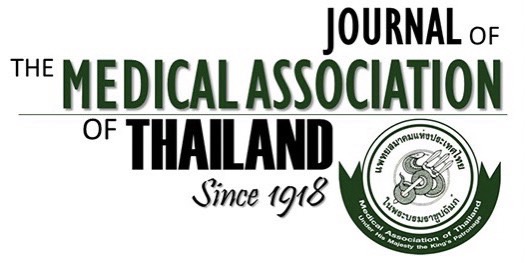Comparison of Clinical and Polysomnographic Characteristics of Non-Obese and Obese Patients with Obstructive Sleep Apnea
Nitipatana Chierakul MD*, Chanchai Chaipattarapol MD*, Pimon Ruttanaumpawan MD*, Arth Nana MD*, Chana Naruman MSc*, Suwat Tangchityongsiva MSc*
Affiliation : * Division of Respiratory Disease and Tuberculosis, Department of Medicine, Faculty of Medicine Siriraj Hospital, Mahidol University, Bangkok
Objective : To compare the clinical features, anthropometric indices, and polysomnographic data between
different body mass index (BMI) subgroups of obstructive sleep apnea (OSA) patients.
Materials and Methods : The authors reviewed the data from OSA patients in Siriraj Sleep Clinic from April
2005 to September 2006. Objective measurement for sleepiness (Epworth Sleepiness Scale, ESS), anthropo-
metric measurements [body mass index (BMI), neck circumference, thyromental distance, Mallampati’s score,
and occlusion pattern] and polysomnographic recordings [apnea/hypopnea index (AHI) during REM and
NREM periods, respiratory arousal index, periodic leg movement index, minimal oxygen saturation, total
sleep time with oxygen saturation < 90%, and desaturation index] were collected. The patients were stratified
into the non-obese group and obese group if their BMI was < 27 or ≥ 27 kg/m2 respectively.
Results : Of the total 158 patients, 71 were non-obese and 87 were obese, no difference in mean age and sex
was observed, but more patients with hypertension and coronary artery disease were noted in the obese
group. Mean ESS was not different between the 2 groups. In anthropometric measurements, the obese group
had statistically significant large neck circumference (41.6 ± 3.5 cm vs 37.0 ± 2.9 cm, p < 0.001), but the non-
obese group had a shorter thyromental distance (56.4 ± 11.7 mm vs 61.4 ± 11.2 mm, p = 0.006), with no
significant difference in Mallampati’s score and occlusion pattern. In polysomnographic data, the obese
group had statistical significantly more severity of various indices except for AHI during the REM period and
the periodic limb movement index.
Conclusion : Non-obese obstructive sleep apnea patients have more bony structural change than the obese
ones as demonstrated by shorter thyromental distance. But degree of abnormalities during sleep was less
severe in nearly all aspects.
Keywords : Obstructive sleep apnea; Thyromental distance; Non-obese patients



